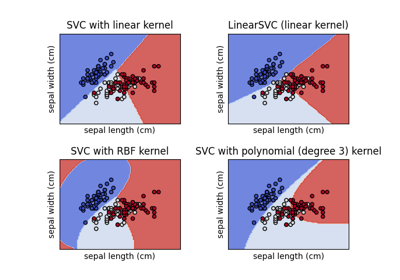Note
Go to the end to download the full example code. or to run this example in your browser via Binder
带有自定义核函数的SVM#
使用支持向量机对样本进行分类的简单示例。它将绘制决策面和支持向量。

import matplotlib.pyplot as plt
import numpy as np
from sklearn import datasets, svm
from sklearn.inspection import DecisionBoundaryDisplay
# 导入一些数据来玩玩
iris = datasets.load_iris()
X = iris.data[:, :2] # we only take the first two features. We could
# 通过使用二维数据集来避免这种丑陋的切片
Y = iris.target
def my_kernel(X, Y):
"""我们创建一个自定义核函数:
(2 0)
k(X, Y) = X ( ) Y.T
(0 1)
"""
M = np.array([[2, 0], [0, 1.0]])
return np.dot(np.dot(X, M), Y.T)
h = 0.02 # step size in the mesh
# 我们创建一个SVM实例并拟合我们的数据。
clf = svm.SVC(kernel=my_kernel)
clf.fit(X, Y)
ax = plt.gca()
DecisionBoundaryDisplay.from_estimator(
clf,
X,
cmap=plt.cm.Paired,
ax=ax,
response_method="predict",
plot_method="pcolormesh",
shading="auto",
)
# 还要绘制训练点
plt.scatter(X[:, 0], X[:, 1], c=Y, cmap=plt.cm.Paired, edgecolors="k")
plt.title("3-Class classification using Support Vector Machine with custom kernel")
plt.axis("tight")
plt.show()
Total running time of the script: (0 minutes 0.043 seconds)
Related examples





